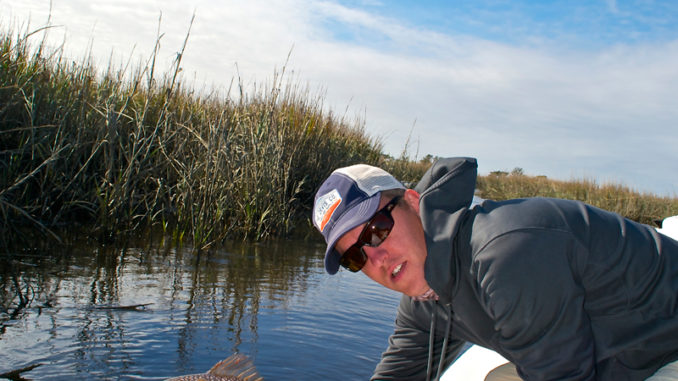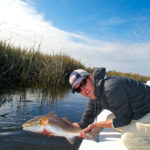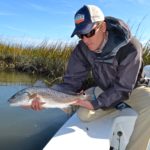
The high end of the tide cycle can provide some great fishing for reds in the waters around Georetown.
When February rolls around in South Carolina’s tidal marshes, the pressure is on for redfish. With groceries scarce and hundreds of anglers ready to rip some lips, they become easy targets for those using the correct tactics. But the typical low-tide approach may not always be the best opportunity during the dead of winter.
Redfish are loved by most fishermen in South Carolina and every other state where these fish swim. They provided year-round opportunities for action, living from the saltiest of saltwater all the way upstream to the boneyards where the water is so fresh that barnacles don’t survive. When winter comes, falling water temperatures change the daily habits of marine life in inshore waters and must learn how to manage energy reserves, find food and stay out of harm’s way.
This time of year, redfish are undoubtedly the primary target of fishermen who launch and head to the waters of Winyah Bay east of Georgetown’s historic port. Arguably, February is one of the best times to declare war on a school of chunky reds.
Traditionally, most anglers target redfish on low water in deep pools in the backs of creeks. They are piled up in big schools but are very sensitive to pressure when the winter offensive is well underway.
Jeff Lattig of Living Water Guide Service spends many days chasing reds, and winter is his prime season to target them. While he fishes during low water, he prefers to target reds on higher tides when they are in a better mood.
“Fish are much happier on high water,” Lattig said. “Our waters around Georgetown get plenty of anglers during the winter, but most people are missing out on the high-water bite. The fish are much more cooperative.”
In low-water situations, as soon as anglers start hooking fish, the rest of those in a school become conflicted and very leery of unnatural vibrations and sounds; they fear for their lives.
Like Lattig, Newman Weaver of Kingfisher Guide Service tries to avoid fishing for reds on low water to improve his chances of catching fish and to protect the fishery.
“February is the hardest time on the fish, because the fishing pressure on low water, and they are really in a state of shock that can lead to a high mortality rate,” Weaver said. “Fishing on higher water can bring better action and produce less stress on the school.”
Reds are much more aggressive on higher water because they don’t feel the pressure they do on low water.
“You cannot hem them up on high water,” Weaver said. “The school can easily move away from you with plenty of places to go.”
For anglers not accustomed to high-water fishing, the search doesn’t have to last long, because fish don’t move far between the ends of the tide cycle. As the incoming tide floods the creeks, these large schools gain access to marsh grass and mud bars and have deeper water to maneuver in. But they really don’t travel very far at all.
Lattig first looks for shallow mud bars immediately adjacent to low-tide depressions.
“The best mud bars are the ones that have one to two feet of water on them at high tide. They move on these mud bars for safety, warmth, and to feed,” he said.
Warmth is an important factor in winter, and the sun’s radiant heat can raise water temperatures several critical degrees. As a result, Lattig will look to avoid early morning launches, replacing them with a mid-day or afternoon trip.
“We try to do everything mid-day and during the warmest part of the day. What is generally tolerant for us is also acceptable to the fish,” he said.
In some instances, Lattig will totally abandon the secondary creek system, but only when the fish do.
Schools of reds will pull out to the main bodies of creeks and at times take refuge along the shallow oyster bars adjacent to the deep channels when a series of prevalent winds and tides coincide in a perfect storm.
“If we get a west wind for two weeks and a negative tide, the places that were holding a 50-fish school will get forced out to the main creek because the creeks dry up,” Lattig said.
Quite often, many of these fish will remain along the main creeks up next to the grass after these extreme tide situations dissipate. Weaver also targets these main creek edges during the winter, even on higher stages of the tide, even if only because reds are less spooky when surrounded by plenty of water. He targets them along steep shell banks on the edges of the main creeks close to the secondary creek mouths. These fish can provide some fantastic fishing opportunities.
“These fish don’t get the same amount of pressure because everybody is targeting the creek fish on low tide,” said Weaver, who will target them right up on shell-covered banks next to the grass, close to the surface where they can warm up and feed on any available bait taking advantage of the warm conditions.
“The shell banks where two creeks come together in the larger creeks or at mouth of feeder creeks are good places to look for them along the main creek,” he said.
The best aspect of fishing for reds in the winter is the way these fish feel about food. Anglers can use a wide variety of artificial options and have little problems getting an unpressured fish to eat. But to be safe, small, scented soft plastics are productive options.
“Scented baits are definitely a wintertime staple, but I will scale them down a touch. Smaller, lighter lures land softer and have a more natural presentation that the large chunky lures we use in the summertime,” Lattig said.
Small, 3-inch, artificial shrimp like the D.O.A. are a perfect option, along with smaller Gulp baits or scented Z-man baits. Lattig fishes them on a 1/8-ounce jighead or a lightly-weighted flutter hook.
Weaver is a big fan year-round of D.O.A. shrimp, and he will use them in about any color available.
“I like golden bream with glow tail, white, gold rush, but it really doesn’t make any difference. They will eat about any color this time of year because they are very hungry,” he said.
Lattig and Weaver guide for a lot of fly-fishermen, and when they do, they tie on a lightly-weighted shrimp or toad pattern in a flash.
“The soft and gentle presentation of a hand-tied fly is the perfect offering during the winter, and I have a No. 1 color, too. The first thing out of my box is a black and purple fly of any kind, but I will also use pink and natural colorations, too,” Lattig said.
The woes of winter don’t have to keep anglers locked up away from their favorite pastime. Even though February is the coldest month, the redfish opportunities in Winyah Bay shouldn’t be missed. And don’t forget about targeting reds on the higher tides for the fish are the most cooperative in the right places and with the right stuff.
DESTINATION INFORMATION
HOW TO GET THERE — The waters around Georgetown, including North Inlet, Winyah Bay and Santee Delta, are accessible from three public boat ramps: South Island Ferry southeast of Georgetown on South Island Road, the East Bay Park landing at the ballpark in downtown Georgetown and the Campbell marine complex just south of the US 17 bridge over the Sampit River.
WHEN TO GO — Reds will bite year-round, but the winter pattern begins in December and continues through March. Try to fish on warm, sunny days and look for the right tide cycle in the early afternoon.
BEST TECHNIQUES — Fish small, scented soft-plastic baits rigged on light jigheads or flutter hooks. A gentle approach is recommended. The scented nature of these lures and an occasional twitch is all that is needed to trigger a strike. Use medium-action spinning tackle and braided line. Fly fishermen should use small flies up to 3 inches tied on hooks from No. 2 to 1/0. Light Clousers, toad flies, craft shrimp and crab imitations are ideal for winter redfish. They should be constructed to sink very slowly or be neutrally buoyant. Natural fibers, such as deer hair, marabou and rabbit fur will keep the fly from sinking too fast. Black bead chain or small dumbbell eyes should be used. Gentle movement is preferred with a slow sinking action ideal. Natural colors of brown, tan, and olive will produce, as well as blacks and purples. Use 8- to 10-weight rods, floating line and 10- to 12-foot fluorocarbon tippets.
FISHING INFO/GUIDES — Jeff Lattig, Living Water Guide Service, 843-997-4655, www.livingwaterguide.com; Newman Weaver, Kingfisher Guide Service, 843-318-0474, www.gtownkingfisher.com; Georgetown Icehouse, 843-546-6169); Pawley’s Island Outdoors, 843-979-4666. See also Guides and Charters in Classifieds.
ACCOMMODATIONS — Hampton Inn-Georgetown Marina, 843-545-5000; Georgetown Area Visitors Center, www.visitgeorgetown.com.
MAPS — Navionics, www.navionics.com, 800-848-5896; Delorme S.C. Atlas and Gazetteer (www.delorme.com; 800-561-5105) Capt. Seagull’s Nautical Charts, 888-473-4855, www.captainsegullcharts.com.






Be the first to comment